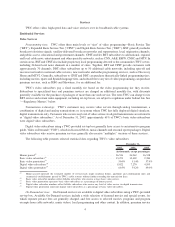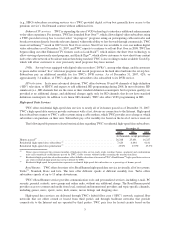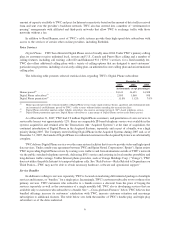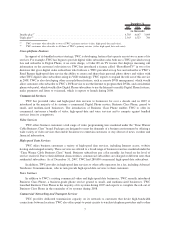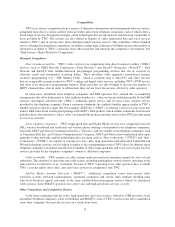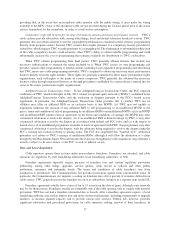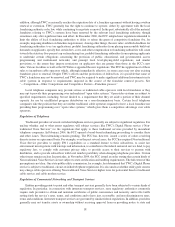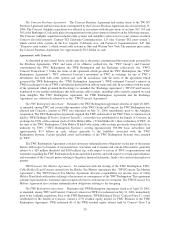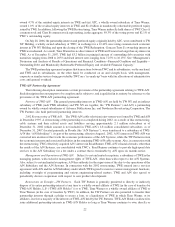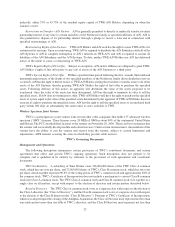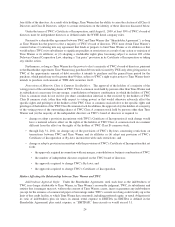Time Warner Cable 2007 Annual Report Download - page 19
Download and view the complete annual report
Please find page 19 of the 2007 Time Warner Cable annual report below. You can navigate through the pages in the report by either clicking on the pages listed below, or by using the keyword search tool below to find specific information within the annual report.operator for the minimum level of video programming service, referred to as basic service, which generally includes
local broadcast channels and public access or educational and government channels required by the franchise. This
kind of regulation also applies to the installation, sale and lease of equipment used by subscribers to receive basic
service, such as set-top boxes and remote control units. In many localities, TWC is no longer subject to this rate
regulation, either because the local franchising authority has not become certified by the FCC to regulate these rates
or because the FCC has found that there is effective competition.
Carriage of broadcast television stations and other programming regulation. The Communications Act and
the FCC’s regulations contain broadcast signal carriage requirements that allow local commercial television
broadcast stations to elect once every three years to require a cable system to carry their stations, subject to some
exceptions, or to negotiate with cable systems the terms by which the cable systems may carry their stations,
commonly called “retransmission consent.” The most recent election by broadcasters became effective on
January 1, 2006.
Apart from those local commercial broadcast stations that elect retransmission consent, the Communications
Act and the FCC’s regulations require a cable operator to devote up to one-third of its activated channel capacity for
the mandatory carriage of local commercial television stations and certain low-power stations. The
Communications Act and the FCC’s regulations give local non-commercial television stations mandatory
carriage rights, but non-commercial stations do not have the option to negotiate retransmission consent for the
carriage of their signals by cable systems. Additionally, cable systems must obtain retransmission consent for all
“distant” commercial television stations (i.e., those television stations outside the designated market area to which a
community is assigned) except for commercial satellite-delivered independent “superstations” and some low-power
television stations.
FCC regulations require TWC to carry the signals of both commercial and non-commercial local digital-only
broadcast stations and the digital signals of local broadcast stations that return their analog spectrum to the
government and convert to a digital broadcast format. The FCC’s rules give digital-only broadcast stations
discretion to elect whether the operator will carry the station’s primary signal in a digital or converted analog
format, and the rules also permit broadcasters with both analog and digital signals to tie the carriage of their digital
signals to the carriage of their analog signals as a retransmission consent condition.
In 2005, the FCC reaffirmed its earlier decision rejecting multi-casting (i.e., carriage of more than one program
stream per broadcaster) requirements with respect to carriage of broadcast signals pursuant to must-carry rules.
Certain parties filed petitions for reconsideration. To date, no action has been taken on these reconsideration
petitions, and TWC is unable to predict what requirements, if any, the FCC might adopt.
In September 2007, the FCC adopted an order that requires cable operators that offer at least some analog
service (i.e., that are not operating “all-digital” systems) to provide to subscribers both analog and digital feeds of
must-carry broadcast stations beginning February 18, 2009, regardless of whether both feeds are provided to the
cable operator. Currently, this obligation is scheduled to terminate in February 2012, subject to FCC review. As of
February 2008, certain technical specifics of how post-transition carriage will be accomplished, such as signal
format and resolution, remain unresolved by the FCC. The Company is unable to predict what requirements, if any,
the FCC might adopt or the timing of such action.
The Communications Act also permits franchising authorities to negotiate with cable operators for channels
for public, educational and governmental access programming. It also requires a cable system with 36 or more
activated channels to designate a significant portion of its channel capacity for commercial leased access by third
parties, which limits the amount of capacity TWC has available for other programming. The FCC regulates various
aspects of such third-party commercial use of channel capacity on TWC’s cable systems, including the rates and
some terms and conditions of the commercial use. In November 2007, the FCC adopted an order revising its leased
access rules by lowering the permitted rate charged to most leased access programmers, as well as adopting new
procedural and complaint provisions. The FCC is seeking further comment on whether to extend the new rate
methodology to program-length commercial and sales programming. In addition, the FCC has also launched a
proceeding to examine its substantive and procedural rules for program carriage. TWC is unable to predict whether
any such proceedings will lead to any material changes in existing regulations.
14


